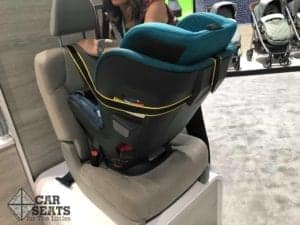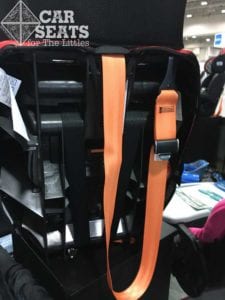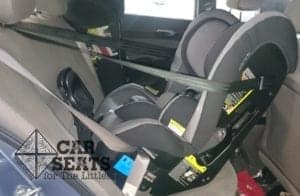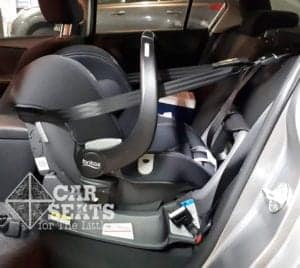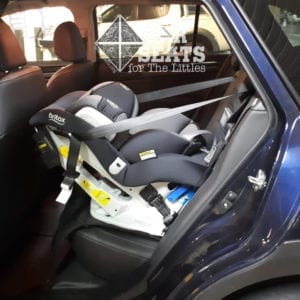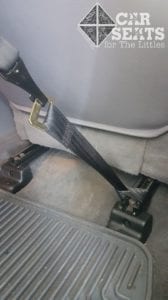With UPPAbaby’s announcement about their upcoming convertible car seat, we had a barrage of questions about the rear facing tether that appeared on the KNOX. While it appears that the KNOX’s tether is kind of unique, we can’t speak to the intricacies of that particular tether just yet.
But! We can most certainly offer an overview of tethering and a brief introduction to rear facing tethers so when the seat is released, this type of tether will be familiar.
First and foremost, do not fear the rear (facing tether). These tethers were tested along with the car seat. They ship with the car seat — they’re by no means an aftermarket product.
Our Tale of Many Tethers is a brief world tour of car seats.
Tethers Around the World
Forward Facing Tethers — We’re Used to That!
A top tether isn’t a new concept for caregivers in the United States — it’s a crucial part of a forward facing harnessed car seat. The top tether is used in addition to the vehicle seat belt or lower anchors (called UAS in Canada and ISOFIX in the EU and Australia). It reduces head excursion by 6-8 inches in a forward facing car seat. That’s a big safety advantage for a little piece of webbing with a hook on it!
Australian, Canadian, and American caregivers should already be familiar with using the top tether on their child’s forward facing harnessed car seat. These car seats are installed using the vehicle seat belt (or possibly ISOFIX, UAS, or lower anchors), and tethered to the back of the car with a top tether. In Europe these tethers are a more recent addition, but we’re seeing more and more car seats that include this crucial safety feature.
So far, none of this should be a surprise to our fair readers. Until the next header.
Rear Facing Tethers. What?
Top tethers go together with forward facing car seats like bread and butter but a rear facing tether is a bit of an anomaly in the United States. In the past, a handful of car seat manufacturers allowed for rear facing tethering but today, that number is pretty darn small so the practice is pretty rare. Instead, we tend to see an anti-rebound bar on some higher end car seats.
Rear facing tethers are old hat to our friends from the EU and Australia. All Australian rear facing car seats, whether they are rear facing only seats (colloquially called “capsules”) or convertible car seats, are tethered to the same vehicle tether point that a forward facing seat would be tethered to, around the child restraint and back toward the back of the car.
That’s a little hard to picture. But we’ve got pictures to make it easier to visualize!
In a crash, the Australian style rear facing tether limits the rotation toward the front of the vehicle: the tether is required for these seats to meet Australian standards and is not optional.
North American caregivers tend to look at rear facing tethers and think they must be horribly inconvenient. We agree that loading children into a car seat is not convenient, but most rear facing car seats offer a way to lower and then tighten the tether while loading or unloading the child.
Rear facing only car seats involve removing and replacing the tether to remove the carrier from the car.
Actual Use
While dealing with a tether on a regular basis in this way is a foreign step for North Americans, Australian car seats, like European car seats ones, do not have chest clips. So the steps for loading a child into, say, an American Evenflo SureRide are:
- Place child’s bum in seat
- Slide the child’s arms through the harness straps
- Buckle the crotch buckle
- Connect the child’s chest clip, then tighten the harness until it can pass the Pinch Test
And the steps for loading a child into, say, an Australian BabyLove EzySwitch are
- Place the child’s bum in the seat
- Slide the child’s arms through the harness straps
- Buckle the crotch buckle then tighten the harness
- Remove slack from tether
Both car seats require the same number of steps but the last step is a little different when there’s a rear facing tether involved.
European Rear Facing Tethers
European rear facing tethers function differently from their Australian or American counterparts. Unlike the
Australian rear facing tethers, rear facing tethers in Europe affix the seat toward the front of the car, either to a dedicated tether anchor that is not the forward facing anchor or to the base of the front seat. Confused? Here’s a photo!
These types of tethers are commonly called Swedish style rear facing tethers. Their use is not optional in a number of European rear facing car seats.
On car seats that have load legs, these tethers are tightened and serve to produce the proper amount of force on the load leg, securely installing the rear facing car seat and controlling over rotation towards the front of the vehicle.
When this Swedish flavor of rear facing tether is used with European car seats, the instructions will indicate that caregivers need to tighten the webbing quite a bit.
Swedish Style Tethering in the United States
Some other rear facing car seats, including a handful of North American models, use a different style of tether that also affixes towards the front of the car (and is also often called “Swedish style tethering”). When it’s used in American vehicles for American car seats, this variety of rear facing tether is installed around a point that’s affixed to the vehicle frame, usually the leg of the front vehicle seat. American-based car seat manuals tend to instruct caregivers to remove the slack from the webbing without overtightening.
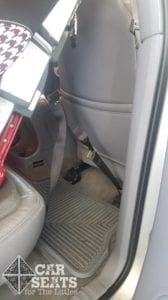 This rear facing tether point serves as energy control in a crash controlling the rotation towards the back of the car as the seat rebounds. Many North American car manuals will explicitly prohibit the use of Swedish style tethering. As always, the best answer for your situation is the one your car seat and your vehicle’s manual provide.
This rear facing tether point serves as energy control in a crash controlling the rotation towards the back of the car as the seat rebounds. Many North American car manuals will explicitly prohibit the use of Swedish style tethering. As always, the best answer for your situation is the one your car seat and your vehicle’s manual provide.
If you find yourself using a car seat with a rear facing tether, don’t be afraid. Just read your car seat’s manual and set up the rear facing tether properly.

